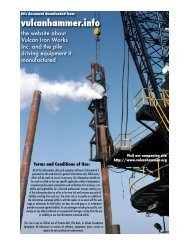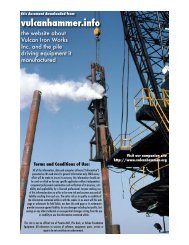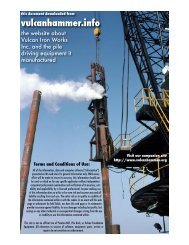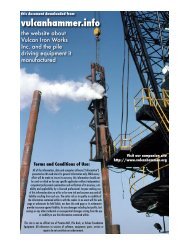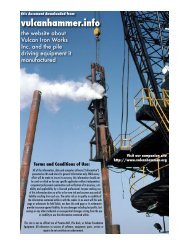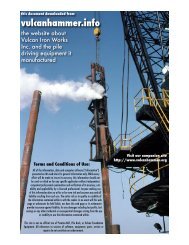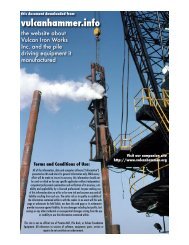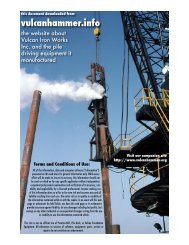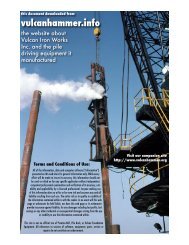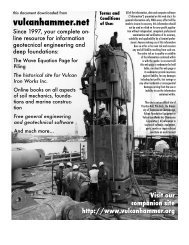Dynamic Prediction of Pile Static Bearing Capacity - vulcanhammer ...
Dynamic Prediction of Pile Static Bearing Capacity - vulcanhammer ...
Dynamic Prediction of Pile Static Bearing Capacity - vulcanhammer ...
Create successful ePaper yourself
Turn your PDF publications into a flip-book with our unique Google optimized e-Paper software.
tI5114 f b hTarch, 1969 Shl 2TITE THEORETICAL PILE MODEI,Consider the pile mode! <strong>of</strong> length L shown in Fig. 1, where .Y representsthe rigid body motion <strong>of</strong> the pile, x the distance coordinate nlong the pile <strong>of</strong> asystem <strong>of</strong> ases moving with the pile arid : the elastic deflecklon <strong>of</strong> the pint vawny from its rest position. Let concentrated forces, functions <strong>of</strong> time, FT(l)and FB (11, act upon the top and bottom respectively <strong>of</strong> the pile, and let RL(x, 1)be the distributed resistive force <strong>of</strong> the soil along the length <strong>of</strong> the pile.The top force F~(I) = the hammer force transmitted to the pile. FB (f) = aconcentrated reactive force due to the soil resistance; R=(I-, t) is a distributedfrictional force. h the model to be cons!dered here, ~ ~ ( will 1 ) be takenas the actual input force <strong>of</strong> the hnmmer as measured at the pile top for example,by a suitable force transducer. (See Rcfs. 8 and 9 and Appendix 11.)--'ainwhich E(1) is thc finite Fourier Cosine transform <strong>of</strong> the rigid body contri- (11..,--% @.- ., .,,1 !tmtion xlti the strrnnlation <strong>of</strong> [, ternls covers the transfor~ncd elastic contri- ,:;!j:.:.!I : I#,-,-,:: 'bution. When the displacement Z isohtninc4 froni Eq. 2, successfve numerical.... ;::'''.-'.;,,;!:d:.iidifferentinttons yield the theoreticnl velocity and acceleration, respectively. . . ..,411 terms <strong>of</strong> Eq. 2 arc c.qltcit]y derived in Appendix I. Itwill merely be re- ,,I-,iitcrated here that these terms are all functions <strong>of</strong> the hamnler force F~(I) ,--~ Ill:SlS rlVE FOIICI:SFB (t) will be !.?ken as zel-o in the present shldy, its cffcct (if any) bclng includedIn the dis!riht+ resistive force liL(.r,t), which will be dlscusscdsubsequently.The basic governing equation for the pile is t!~e elastic wave ec!u:ltiori. Dchils<strong>of</strong> this are considered in Appendix I. At the pile to)) (r = 0) the total dynar??icdisplacctnent under the hnnirner blow is e>:presscd by % (0, I)in which Z =A'+ 5 ................................ (1)is the sum 01 rigid body (X) and elastic (!,) con!ril~utior~s. The nct result(solution <strong>of</strong> the wave equation) may be stated in the formTIME IN MILLISECONDSConin~enls on lllc fonn nssurncd for these laws are also made in Appendix1. Esscntlally, ln lhc ex:~niples Ire:itcd in the prcscnt work, the laws are takenas (a) ;r siniplc dl~tril~l~il Coulonlb rcsistnncc nlonl: thc sicics and 01) =0, i.c. no point bc:~ring.In cnlculntion, thc Coulomb rcsistnncc was taken to be very small until thetlnle 1, , corrcslmild\n~ closely to Ihc 11c:tk bl ttlt: ~ne;tsurc.ci vc.locity responsecurve; thc fill1 reslat;lncc value W:ls cn~ployed thcr.c:tflcr. This full rcsistnnccv;\lue is callrtl C, ;~rvl Llic dctcrnlir~ition <strong>of</strong> ;i proper \.nluc for it is the prin-



